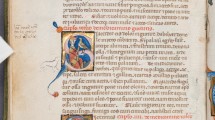Abstract
Mural paintings which decorate the external façade and the internal apsidal wall of a chapel dedicated to St. Maxime and located at Challand St. Victor in the Aosta Valley (Italy) have been analysed with a combined approach involving high-resolution fibre-optic reflectance spectroscopy (FORS), X-ray fluorescence (XRF) spectrometry and Raman spectroscopy. The paintings are attributed to Giacomino from Ivrea, a painter active around the mid-fifteenth century. In order to characterise the palette used by the painter and to yield information useful to restorers, the cited techniques were used either in situ with portable instruments and in laboratory, working on micro samples withdrawn from paintings. The global analytical approach, though not entirely non-invasive, can indeed be considered non-destructive as multiple analyses, including SEM-EDX, could be carried out on the micro samples, exploiting the features of each technique. On the basis of the information obtained, the palette was found to be composed of typical fresco pigments such as calcite, azurite, malachite, vermilion, red and yellow ochres. A particular situation was noted for black pigments since the presence of graphite, rather than wood or lamp carbon, was found, possibly related to the presence of graphite deposits in the Aosta Valley. Furthermore, the presence of smalt superimposed to azurite in areas showing evidence of repainting was detected, suggesting that paintings were subjected to retouching at a relatively early stage after the original execution. Finally, the presence of tin foils, used to decorate haloes of Evangelists, was ascertained.






Similar content being viewed by others
References
Bacci M (1995) Fiber optics applications to works of art. Sensor Actuat B-Chem 29:190–196
Dupuis G, Menu M (2005) Quantitative evaluation of pigment particles in organic layers by fibre-optics diffuse-reflectance spectroscopy. Appl Phys A 80:667–673
Dupuis PG (2008) Painting technique of Italian Renaissance artists evaluated by spectrophotometry. Actual Chim 318:22–27
Perardi A, Appolonia L, Mirti P (2003) Non-destructive in situ determination of pigments in 15th century wall paintings by Raman microscopy. Anal Chim Acta 480:317–325
Moioli P, Seccaroni C (2000) Analysis of art objects using a portable X-ray fluorescence spectrometer. X-Ray Spectrom 29:48–52
Duran A, Perez-Rodriguez JL, Jiménez de Haro MC (2009) Study of gilding technique in polychromed stones and ceramics by dedicated laboratory-made micro-X-ray diffraction and complementary techniques. doi: 10.1007/s00216-009-2836-3, Anal Bioanal Chem, in press.
Gianoncelli A, Castaing J, Ortega L, Dooryhée E, Salomon J, Walter P, Hodeau JL, Bordet P (2008) A portable instrument for in situ determination of the chemical and phase compositions of cultural heritage objects. X-Ray Spectrom 37:418–423
Simova V, Bezdicka P, Hradilova J, Hradil D, Grygar T (2005) X-ray powder microdiffraction for routine analysis of paintings. Powder Diffr 20:224–229
Sodo A, Artioli D, Botti A, De Palma G, Giovagnoli A, Mariottini M, Paradisi A, Polidoro C, Ricci MA (2008) The colours of Etruscan painting: a study on the Tomba dell’Orco in the necropolis of Tarquinia. J Raman Spectrosc 39:1035–1041
Sawczak M, Kaminska A, Rabczuk G, Ferretti M, Jendrzejewski R, Sliwinski (2009) Complementary use of the Raman and XRF techniques for non-destructive analysis of historical paint layers. Appl Surf Sci 255:5542–5545
Brunod E (1987) Arte sacra in Valle d’Aosta, Bassa Vallèe e valli laterali II. Musumeci editore, Aosta
Mühlethaler B, Thissen J (1993) In: Roy A (ed) Artists’ pigments. A handbook of their history and characteristics, vol. 2, national gallery of art. Washington and Oxford University Press, Oxford
Gargano M, Ludwig N, Milazzo M, Moneta A, Poldi G (2006) In: Arias C, Colombini MP (eds) Proceedings of the IV Congresso Nazionale di Archeometria, ETS, Pisa
Theophilus P (1961) In: Dodwell CR (ed) The various arts. Nelson, London
Cesareo R (2003) Non-destructive EDXRF-analysis of the golden haloes of Giotto’s frescos in the Chapel of the Scrovegni in Padua. Nucl Instrum Methods B 211:133–137
Wang X, Zhang FX, Loa I, Syassen K, Hanfland M, Mathis YL (2004) Structural properties, infrared reflectivity, and Raman modes of SnO at high pressure. Phys Status Solidi B 241:3168–3178
Geurts J, Rau S, Richter W, Schmitte FJ (1984) SnO films and their oxidation to SnO2: Raman scattering, IR reflectivity and X-ray diffraction studies. Thin solid films 121:217–225
RASMIN web—Raman Spectra Database of Minerals and Inorganic Materials (2008) National Institute of Advanced Industrial Science and Technology, Tokyo. http://riodb.ibase.aist.go.jp/rasmin/E_index.htm. Accessed 13 July 2009
De Ryck I, Adriaens A, Storme P, Adams F (2004) The tin mercury inlay of a cabinet manufactured by Hendrik Van Soest: a case study. e-Preservation Science 1:9–14
Duran A, Perez-Rodrıguez JL, Jimenez de Haro MC, Herrera LK, Justo A (2008) Degradation of gold and false golds used as gildings in the cultural heritage of Andalusia, Spain. J Cult Herit 9:184–188
Acknowledgments
We would like to acknowledge Dr. Giorgio Gatti (Department of Sciences and Advanced Technologies, University of Eastern Piedmont) for execution and interpretation of SEM-EDX analysis.
Author information
Authors and Affiliations
Corresponding author
Rights and permissions
About this article
Cite this article
Appolonia, L., Vaudan, D., Chatel, V. et al. Combined use of FORS, XRF and Raman spectroscopy in the study of mural paintings in the Aosta Valley (Italy). Anal Bioanal Chem 395, 2005–2013 (2009). https://doi.org/10.1007/s00216-009-3014-3
Received:
Revised:
Accepted:
Published:
Issue Date:
DOI: https://doi.org/10.1007/s00216-009-3014-3




